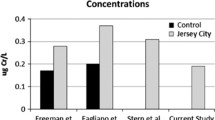Abstract
This study investigated the adverse health outcomes and urinary heavy metal levels in residents exposed to cement dust, compared to those who were not exposed. A total of 374 residents (276 for the exposed group and 98 for the unexposed group) were surveyed. Participant demographics, health-related behaviors (smoking and drinking), medical history, and clinical symptoms were collected using a self-administered questionnaire. Urinary metal levels were determined using an Atomic Absorption Spectrometer (AAS). Clinical adverse health outcomes such as asthma, rhinitis, and dermatitis were found to be more common in the group exposed to cement dust than in the unexposed group. Urinary levels of chromium and mercury were found to be significantly higher in the exposed group compared to the unexposed group. A limitation of this study is that we did not measure air pollution and heavy metals in local soils and plants and the cement dust could not be concluded as the unique origin of those metals because of other sources of those metals. Although these limitation are, these results suggest that exposure to cement dust may lead to chronic symptoms and disease.
Similar content being viewed by others
References
Pordon, L. & Bachofen, G. in Encyclopedia of occupational health and safety (eds Stellman, J.M.) 44–93 (ILO, Geneva, 1998).
Yang, C. Y. et al. Effects of occupational dust exposure on respiratory health of Portland cement workers. J. Toxicol. Environ. Health 49, 581–588 (1996).
Cho, S. H. & Han, S. H. Acute ulcerative contact dermatitis from ready mixed concrete. The Kor. J. Occup. Med. 7, 191–194 (1995).
Yoo, S. H., Kim, Y. G. & Lee, A. Y. Two cases of cement burn. Ann. Dermatol. 12, 197–198 (2000).
Bae, J. M., Kim, M. Y., Park, Y. M. & Kim, H. O. A case of cement burn. Korean J. Dermatol. 44, 586–588 (2006).
Oleru, G. Pulmonary function and symptoms of Nigerian workers exposed to cement dust. Environ. Res. 33, 379–385 (1994).
Abou-Taleb, A. N., Musaiger, A. O. & Abdelmoneim, R. B. Health status of cement workers in the United Arab Emirates. JR. Soc. Health 115, 378–381 (1995).
AbuDhaise, B. A. et al. Pulmonary manifestations in cement workers in Jordan. Int. J. Occup. Med. Environ. Health 10, 417–428 (1997).
Mengesha, Y. & Bekele, A. Relative chronic effects of different occupational dusts respiratory indices and health of workers in three Ethiopian factories. Am. J. Ind. Med. 34, 373–380 (1998).
Alvear-Galindo, M. G. et al. Risk indicator of dust exposure and health effects in cement plant workers. J. Occup. Environ. Med. 41, 654–661 (1999).
Noor, H., Yap, C. L., Zolkepli, O. & Faridah, M. Effects of exposure to dust on lung function of cement factory workers. Med. J. Malaysia 55, 51–57 (2000).
Al-Neaimi, Y. I., Gomes, J. & Lloyd, O. L. Respiratory illnesses and ventilatory function among workers at a cement factory in a rapidly developing country. Occup. Med. 51, 367–373 (2001).
International Study of Asthma and Allergies in Childhood (ISSAC) Steering Commitee. Worldwide variations in the prevalence of asthma symtoms: the International Study of Athma and Allergies in Childhood. Eur. Respir. J. 12, 315–335 (1998).
Kim, C. W. et al. Evaluation and Control of Allergic Rhinitis in Adult Patients with Asthma (CARINA) in Korea. Korean J. Asthma Allergy Clin. Immunol. 27, 248–256 (2007).
Cheong, H. K. et al. A study on the health status of the inhabitants exposed to cement dust. Korean J. Epidemiol. 14, 59–69 (1992).
Suh, D. H. & Eun, H. C. An analysis of chrome in cements and bleaching Detergents. Kor. J. Dermatol. 28, 11–15 (1990).
Al-Khashman, O. A. & Shawabkeh, R. A. Metals distribution in soils around the cement factory in southern Jordan. Environ. Pollut. 140, 387–394 (2006).
Schuhmacher, M. et al. Biological monitoring of metals and organic substances in hazardous-waste incineration workers. Int. Arch. Occup. Environ. Health 75, 500–506 (2002).
Isikli, B. et al. Effects of chromium exposure from a cement factory. Environ. Res. 91, 113–118 (2003).
Isikli, B. et al. Cadmium exposure from the cement dust emissions: A field study in a rural residence. Chemosphere 63, 1546–1552 (2006).
Hellstrom, L. et al. Cadmium exposure pathways in a population living near a battery plant. Sci. Total Environ. 373, 447–455 (2007).
Author information
Authors and Affiliations
Corresponding authors
Rights and permissions
About this article
Cite this article
Cha, K.T., Oh, S.S., Yoon, J.H. et al. Adverse health outcomes in residents exposed to cement dust. Toxicol. Environ. Health Sci. 3, 239–244 (2011). https://doi.org/10.1007/s13530-011-0101-6
Received:
Revised:
Accepted:
Published:
Issue Date:
DOI: https://doi.org/10.1007/s13530-011-0101-6




